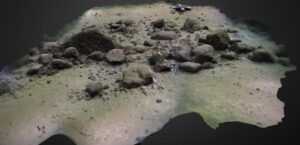
PROCEEDINGS OF THE NATIONAL ACADEMY OF SCIENCES—Researchers uncovered a submerged Stone Age wall that is almost a kilometer in length and may have been used to hunt reindeer. Submerged archaeological sites can remain well-preserved but are often challenging to study in detail. Jacob Geersen and colleagues used hydroacoustic data of up to a centimeter-scale resolution, sedimentological samples, and optical images to characterize a Stone Age megastructure located at a depth of 21 meters in the Bay of Mecklenburg, Germany. The authors used shipborne measurements, an autonomous underwater vehicle, and divers to examine the site. The structure was composed of around 1,670 individual stones, largely less than 1 meter in height and less than 2 meters in width, placed side by side over 971 meters. Geological analysis revealed that the structure was adjacent to the shoreline of a now-submerged lake or bog. The shape and location of the structure were not consistent with a natural origin. The structure was likely constructed by regional hunter-gatherers more than 10,000 years ago and subsequently submerged around 8,500 years ago. The structure may have been used to direct the movements of herds of large ungulates, such as Eurasian reindeer (Rangifer tarandus), to facilitate hunting. According to the authors, the site may represent one of the oldest known hunting structures on Earth and the largest known late Pleistocene/early Holocene structure in Europe.
___________________________

Section of a Stone Age megastructure in the Bay of Mecklenburg, Germany. Philipp Hoy
___________________________
Article Source: PNAS news release
*“A submerged Stone Age hunting architecture from the Western Baltic Sea,” by Jacob Geersen et al., Proceedings of the National Academy of Sciences, 12-Feb-2024. https://www.pnas.org/cgi/doi/10.1073/pnas.2312008121
___________________________
Advertisement

See the incredible archaeology, architecture, and art of northern Spain. A unique tour with special expert guides and lecturers through the collaboration of Popular Archaeology Magazine and Stone & Compass Tours. Not to be missed. Read More About It: https://popular-archaeology.com/article/northern-spains-triple-a-archaeology-architecture-and-art/.
___________________________





